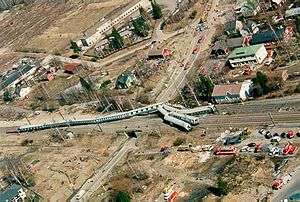Jokela rail accident
 | |||||||||||||||||||||||||||||||||||||||||||||||||||||||||
| Date | 21 April 1996 | ||||||||||||||||||||||||||||||||||||||||||||||||||||||||
|---|---|---|---|---|---|---|---|---|---|---|---|---|---|---|---|---|---|---|---|---|---|---|---|---|---|---|---|---|---|---|---|---|---|---|---|---|---|---|---|---|---|---|---|---|---|---|---|---|---|---|---|---|---|---|---|---|---|
| Time | 07:08 (EEST) | ||||||||||||||||||||||||||||||||||||||||||||||||||||||||
| Location |
Jokela, Tuusula 50 km (31 mi) N from Helsinki | ||||||||||||||||||||||||||||||||||||||||||||||||||||||||
| Coordinates | 60°33′16″N 024°58′02″E / 60.55444°N 24.96722°ECoordinates: 60°33′16″N 024°58′02″E / 60.55444°N 24.96722°E | ||||||||||||||||||||||||||||||||||||||||||||||||||||||||
| Country | Finland | ||||||||||||||||||||||||||||||||||||||||||||||||||||||||
| Rail line | Helsinki–Riihimäki railway | ||||||||||||||||||||||||||||||||||||||||||||||||||||||||
| Operator | VR Group | ||||||||||||||||||||||||||||||||||||||||||||||||||||||||
| Type of incident | Derailment | ||||||||||||||||||||||||||||||||||||||||||||||||||||||||
| Cause | Excessive speed | ||||||||||||||||||||||||||||||||||||||||||||||||||||||||
| Statistics | |||||||||||||||||||||||||||||||||||||||||||||||||||||||||
| Trains | 1 | ||||||||||||||||||||||||||||||||||||||||||||||||||||||||
| Passengers | 139 | ||||||||||||||||||||||||||||||||||||||||||||||||||||||||
| Deaths | 4 | ||||||||||||||||||||||||||||||||||||||||||||||||||||||||
| Injuries | 75 | ||||||||||||||||||||||||||||||||||||||||||||||||||||||||
| |||||||||||||||||||||||||||||||||||||||||||||||||||||||||

The Jokela rail accident occurred on 21 April 1996, at 07:08 local time (04:08 UTC) in Tuusula, Finland, approximately 50 kilometres (30 mi) north of Helsinki. Four people were killed and 75 injured when express train P82 from Oulu, bound for Helsinki, derailed in heavy fog. The overnight sleeper train was carrying 139 passengers and five crew members. The engine overturned and eight of the twelve carriages derailed. The official investigation into the accident revealed that the accident was due to overspeeding through a slow-speed turnout.[1]
It is estimated that the total cost of the accident was over FIM 26 million (€4.3 million).[1][2]
Causes
Railway maintenance work was going on near Jokela railway station, and the usual southbound track was out of service. Because of heavy fog and high speed, the driver was unable to see the distant signal that warned about a divergent routing with a turnout speed limit of 35 kilometres per hour (22 mph) ahead. The visibility was a few dozen metres. Before the accident, drivers of passing trains had reported that the visibility of signals was very low. Moreover, the printed notice about the track diversion, the so-called weekly warning, was confusingly written.[1]
When arriving at the home signal, the train was still running at 133 kilometres per hour (83 mph), having missed the distant signal imposing a limit of 35 kilometres per hour (22 mph). Upon noticing the signal, the driver made an emergency brake application but could only decrease the speed to 124 kilometres per hour (77 mph) before the train entered the turnout. During the journey, the driver had slightly oversped a number of times to maintain the schedule.[1]
Aftermath
The Accident Investigation Board produced 18 recommendations, which included improvements over railway signalling, better seat fixing, improvements on communication and accelerated building of the automatic train control system.[1] However, the Jyväskylä rail accident happened only two years later, showing that more improvements were necessary.[3]
Similar accidents
-
 Milton rail crash – overspeed through turnout
Milton rail crash – overspeed through turnout -
 Bourne End rail crash – overspeed through turnout
Bourne End rail crash – overspeed through turnout -
 Goswick rail crash – overspeed through turnout
Goswick rail crash – overspeed through turnout -
 Waterfall rail accident – overspeed through sharp curve
Waterfall rail accident – overspeed through sharp curve -
 Brühl train disaster – overspeed through turnout
Brühl train disaster – overspeed through turnout -
 Jyväskylä rail accident – overspeed through turnout
Jyväskylä rail accident – overspeed through turnout
See also
References
- 1 2 3 4 5 "A1/1996R Train accident at Jokela, on April 21, 1996" (in Finnish and English). Accident Investigation Board of Finland. Retrieved 2 November 2010.
- ↑ "Elävä Arkisto: Jokelan junaturma" [The Living Archive: Jokela train accident] (in Finnish). YLE. 15 February 2007. Retrieved 2 November 2010.
- ↑ Tommi Rinnemaa (22 April 2004). "Älykäs rautahepo ei vikuroi" (in Finnish). Tekniikka ja talous. Retrieved 30 October 2010.
| Wikimedia Commons has media related to Jokela rail accident. |